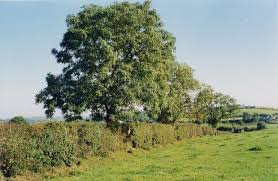Well, today I had another first (this year has been utterly replete with firsts.) I saw a stretch of hawthorn hedgerow – hawthorn is the commonest hedgerow shrub – about twenty feet long which looked dead. Nearly all the hedges in the Shire are looking tired and depleted after the hot, dry summer we’ve been having, but nowhere else do they look dead. In fact, I’ve never seen a dead hedge in the landscape ever, but this one was black and the branches were brittle.
Hedgerows have been a fundamental feature of the lowland British landscape for hundreds of years. Most of those currently defining the patchwork of fields were planted during the various periods of enclosure legislation in the 16th, 18th, and early 19th centuries, and some are even older than that. They’re a lot of work because they have to be trimmed every year, but they’re havens of wildlife and have a character which would be impossible to quantify. I remember there being much concern among environmentalists some decades ago when cereal farmers, especially in the east of England, were grubbing up hedgerows for the sake of more efficient – and therefore more profitable – production, but that seems to have stopped now, thank heaven.








No comments:
Post a Comment